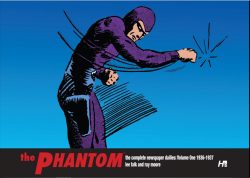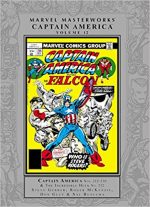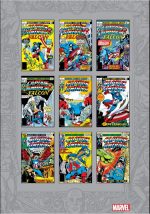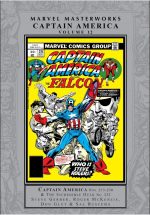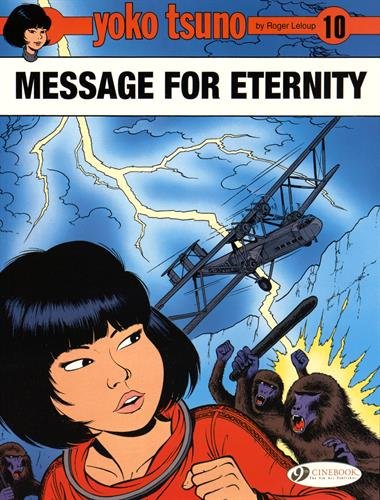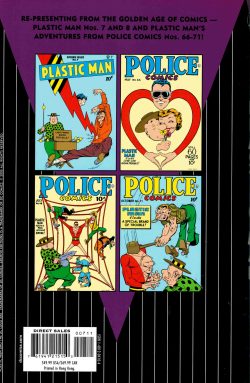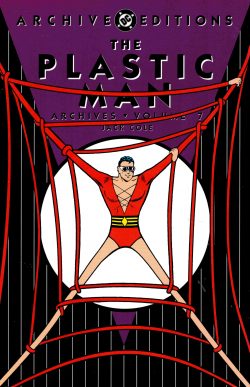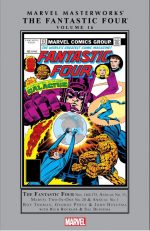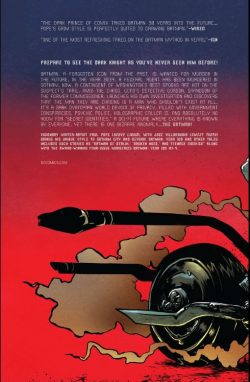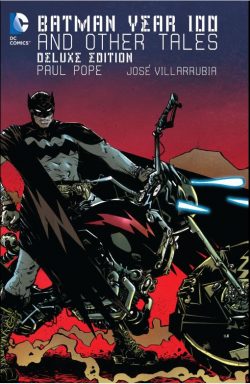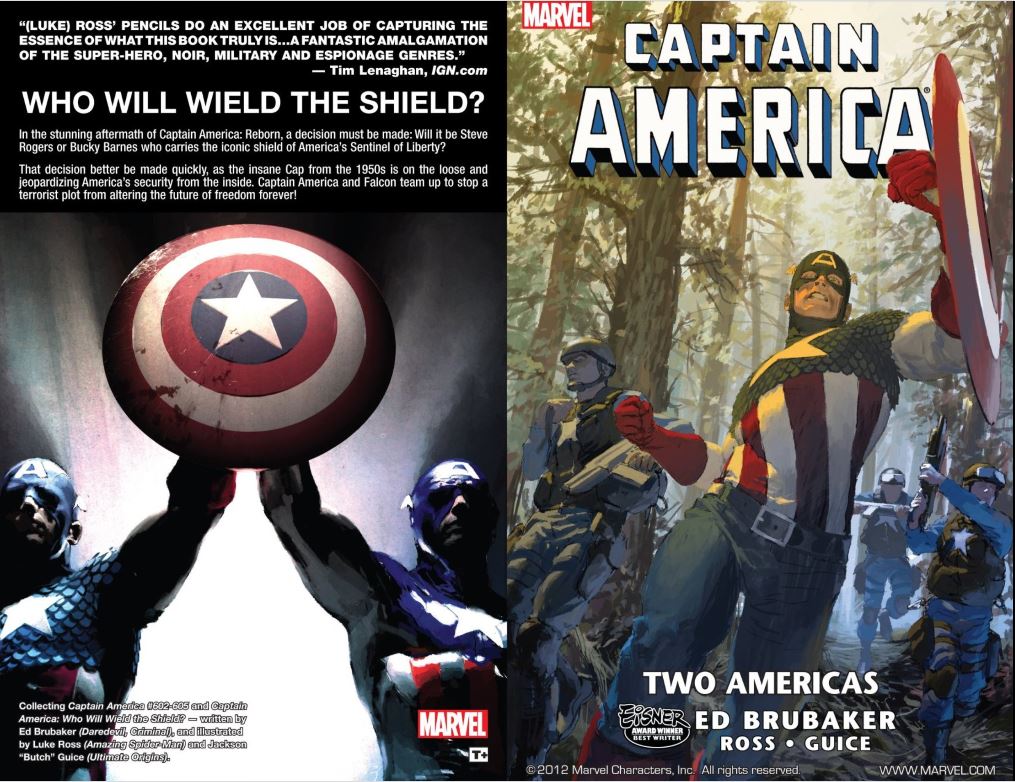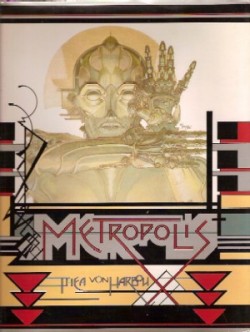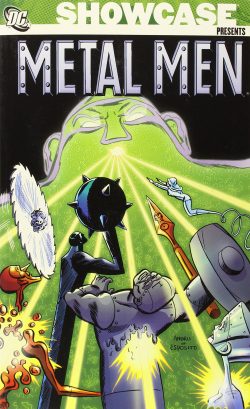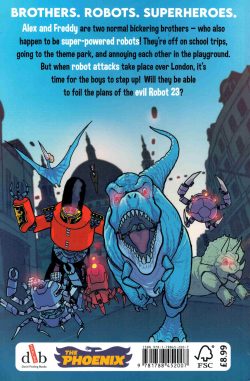

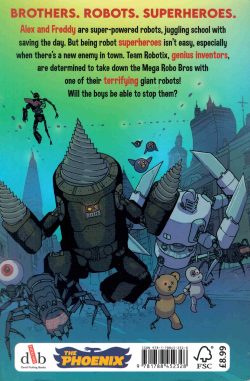
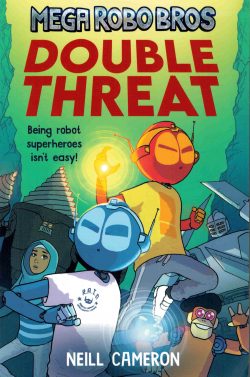
By Neill Cameron with Abby Bulmer & Lisa Murphy (David Fickling Books)
ISBNs: 978-1-78845-200-7 (Power Up PB) and 978-1-78845-232-8 (Double Threat PB)
Just like The Beano, Dandy and other perennial childhood treasures, weekly comic The Phoenix masterfully mixes hilarious comedy with enthralling adventure serials… sometimes in the same scintillating strip. Such I the case here, with the synthetic stars of these superbly remastered compilations: mega-magnificent sci fi frolics packed into full-colour volumes of high-octane comedy-action, with added activity pages to complete your entertainment experience. Everybody strapped in?
Plunging straight into the enchanting immersive experience, we open in a futuristic London on a Monday morning. Alexand his younger brother Freddie have missed the airbus for school and dad has to take them. It’s a uniquely Sharma-family catastrophe…
In most ways the boys are typical: boisterous, fractious kids, always arguing, but devoted to each other and not too bothered that they’re adopted. It’s also no big deal to them that they were created by the mysterious Dr. Roboticus before he vanished and are considered by those in the know as the most powerful robots on Earth.
For now, it’s enough that Mum and Dad love them, even though the Robo Bros are a bit more of a handful than most kids. They live as normal a life as possible; going to school, making friends, putting up with bullies and hating homework: it’s all part of their Mega Robo routine…
This week, though, things are a bit different. On Wednesday the lads meet Baroness Farooq of covert agency R.A.I.D. (Robotics Analysis Intelligence and Defence) who – despite being initially unimpressed – changes her mind after seeing what the lads do to her platoon of Destroyer Mechs – all while between singing rude songs, reading comics and squabbling with each other.
Thursday is even better. As a treat, the entire family goes to Robo World where Freddy rescues a trio of malfunctioning exhibits. The baby triceratops with dog-programming is ok, but the French-speaking deranged ape and gloomily existentialist penguin might be a handful in days to come. …and all because Mum was trying to explain how her sons’ sentience makes them different from other mechanoids…
Friday wasn’t so good. Alex had another one of his nightmares, of the time before they came to live with the Sharmas…
With the scene exquisitely set, the drama kicks into overdrive when a school visit to the museum offers a hidden menace constantly watching the boys an opportunity to create chaos by hacking all the exhibits. Even though Freddy and Alex use all their super-powers to set things right, it takes all of the Baroness’ astounding influence to hush up the incident. They are supposed to be getting as normal a childhood as possible, with friends and family aware that they’re artificial and sentient, but not that they are unstoppable weapons systems. Now some malign force seems determined to “out†the Robo Bros for unspecified but undoubtedly sinister purposes…
Even greater cloaking measures are necessary when the hidden enemy causes a sky-train crash. The boys very publicly prevent a disaster, but even they are starting to realise something big is up. It also confirms that and Mum is a bit extraordinary herself, even before Freddy overhears some disturbing news about another one of Dr. Roboticus’ other creations…
The crisis erupts after Gran takes Alex and Freddy to a Royal Street Party outside Buckingham Palace. When the hidden enemy hacks the giant robot guards and sets them loose on the Queen and her family, the wonder-bots have to save them on live TV beamed around the world. The secret is out…
With the entire world camped outside their quiet little house, Mum has R.A.I.D. restore the Mega Robo Status Quo by building a super-secret tunnel system in the cellar. It’s a big day all around: Farooq is finally convinced that Alex is at last ready to join the agency… after school and on weekends, of course…
Freddy is extremely peeved that that he’s not invited. The Baroness still considers him too young and immature. He soon proves it when Alex becomes a Mega Robo Secret Agent, compelling Freddy to at last confide in dad the real reason he’s acting up. He then has opportunity to redeem himself and save the day when their nemesis makes his move and Alex finds himself completely out of his depth. Then only Freddy can save the day… if anyone can…
Crafted by Neill Cameron (Tamsin of the Deep, How to Make Awesome Comics, Pirates of Pangea), this is an astonishingly engaging tale that rockets along, blending outrageous comedy with warmth, wit and incredible verve. This volume also includes copious files on all the characters and activity features ‘How to Draw Alex’ and ‘How to Draw Freddy’ plus hilarious strip-within-a-strip ‘The World According to Freddy!’.
Alex and Freddy are utterly authentic boys, irrespective of their artificial origins, and their exploits strike exactly the right balance of future shock, family fun and bombastic superhero action to capture readers’ hearts and minds. With the right budget and producer what a movie this would make!
With additional colouring by Abby Bulmer & Lisa Murphy, second volume Mega Robo Bros: Double Threat sees the marvellous metal (and plastic) paladins return to share more of their awesome adventures and growing pains!
It’s still the Future!
In a London much cooler than ours, boisterous, fractious, argumentative, more-or-less typical kids Alex and Freddie are still devoted to each other and not much bothered that they’re adopted, recently became super-secret agents and that almost the entire world knows…
When occasion demands, they undertake missions for Baroness Farooq. They think it’s because they are infinitely smarter and more powerful than the Destroyer Mechs and other man-made minions she employs…
Moreover, Dad might be just be an average old guy, but Mum is a bit extraordinary too…
Life in the Sharma household is pretty normal. Freddie is insufferably exuberant and over-confident whilst Alex is approaching the age when self-doubt and anxiety start kicking in, but mostly it’s their parents’ other robot rescues that are a bit of a trial.
Baby triceratops Trikey with his dog-programming is ok, but French-speaking loony ape Monsieur Gorilla can be mighty confusing. Gloomily annoying, existentialist aquatic fowl Stupid Philosophy Penguin constantly quotes dead philosophers and makes people rapidly consider self-harm or manic mayhem …
Alex is getting a hard time from classmates Mira and Taia. They used to be best friends, but with all his extra-curricular activities, the girls are feeling neglected. Alex’s guilt turns to something far worse on Monday after a heated football match leads bully Jamal to make a startling accusation. But actually, how do we know if Alex is a Boy or a Girl…?
Deeply shaken, the startled hero naturally asks Mum and she’s never been more grateful for a sudden sneaky Surprise Giant Robot Attack that interrupts her answer…
Alex and Freddie are then called in by the Baroness, before jetting over to Aldgate Tube Station to battle a colossal driller-droid. Further investigation leads the lads and a R.A.I.D. science team deep, deep, deep into the abandoned transport tunnels beneath the city….
Here they encounter an army of rejected, rebuilt robots undertaking the bizarre agenda of a crazy bag-lady calling herself The Caretaker. When she abruptly loses control of her precious charges, all Hell breaks loose. During a massive fight, she escapes to an even more secret lair: an ongoing repair project with hidden ramifications that will have dire consequences for the bombastic boys and the entire world…
Freddie experiences Mum’s stern side when she takes him – kicking and screaming – clothes shopping, after which shameful incident, further mortification and emotional distress arrives as the price of fame is fully paid when Prettiest Girl in School Jamila finally notices Alex.
With his shiny head all turned around, he’s in no mood for Freddie’s jealous response: candid home videos posted on VuTube. The elder sibling’s even less chuffed when those postings go mega-viral, drawing some cruel comfort when Freddie’s celebrity bubble inevitably implodes in a most unfortunate manner…
Wrapping up with a spectacular big finish, the kids – and their surprisingly famous mum – are star guests at the massive London Robo Expo. After taking down obnoxious, fame-craving mech-makers Team Robotix in a gladiatorial contest, the lads understandably think the action portion of the entertainment has ended, only to see the Caretaker’s darkest secret burst in with mass-murder in mind…
The huge rampaging robot quickly reinforces all humanity’s fears and anxieties about sentient mechanicals, but as the Mega Robo Bros drive the belligerent Wolfram off, Alex realises with alarm that Mum knows far more about the rogue – and her own “sons†– than she’s ever let on…
Augmented by more character info-files on the players involved; activity features (an extended) ‘How to Draw Freddy’and ‘How to Draw Stupid Philosophy Penguin’ plus even-more outrageous ‘The World According to Freddy!’ strips, this is another exceedingly engaging romp which rockets along like an anti-gravity rollercoaster, blending mirth with warmth, wit and incredible verve. These books offer unmissable excitement for kids of all ages and vintage, and are true “must-have†items.
Text and illustrations © Neill Cameron 2021. All rights reserved.
Both Mega Robo Bros collections will be released on August 5th 2021 and are available for pre-order now.


